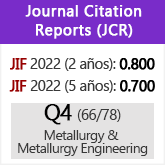Caracterización de pepitas de hierro obtenidas a partir de la reducción de un concentrado de óxido de hierro en un horno de microondas utilizando un reductor basado en biomasa
DOI:
https://doi.org/10.3989/revmetalm.250Palabras clave:
Biomasa, Magnetita, Pellets compuestos, Pepita de hierro, Reducción por microondas, Residuos carbonizados de plantas de téResumen
Este estudio se ocupa de la caracterización de pepitas de hierro obtenidas a partir de la reducción de un concentrado de óxido de hierro en un horno de microondas utilizando un agente reductor basado en biomasa. En los experimentos se utilizó el concentrado de mineral de hierro compuesto por minerales de hematita y magnetita procedente de la región de Elazig y que contenía un 67,29% de Fe tras su enriquecimiento, y como agente reductor, residuos vegetales de té que contenían un 94,68% de C y un 0,03% de S tras su carbonización. El carbono necesario para la reducción de los óxidos de hierro a hierro se añadió estequiométricamente al concentrado con un tamaño de grano de -45 µm tras ajustar su relación de basicidad. Los gránulos compuestos producidos tras la adición de agente reductor y fundente (CaO) se sometieron a reducción en un horno microondas doméstico a diferentes tiempos. Tras el proceso, se obtuvieron unos resultados óptimos (Fe3O4+Fe2O3)/C=1/4, relación de basicidad (CaO+MgO)/(SiO2+Al2O3) =1,2. Se observó que la parte metálica contenía 96,6% de Fe, 2,4% de C después de separarse de la escoria y que la fase metálica se separaba de la escoria muy fácilmente. Como resultado de las investigaciones de microestructura, se comprobó que el producto obtenido tenía propiedades similares a las de la fundición blanca.
Descargas
Citas
Agrawal, B.B., Prasad, K.K., Sarkar, S.B., Ray, H.S. (2000). Cold bonded ore-coal composite pellets for sponge ironmaking Part 1 Laboratory Scale Development. Ironmak. Steelmak. 27 (6), 421-425.
https://doi.org/10.1179/030192300677723
Arancı, E.Ö., Bostancı, B., Benkli, Y.E., Boyrazlı, M., Çizmecioğlu, Z. (2017). The Effect of Using Potato Starch as a Binder on the Pellet Strength of Cold-Hardened Pellets. IATS'17, 3622220.
Benkli, Y.E. (2008). Soğukta Sertleşen Kompozit Peletlerin Yarı Ergitme Şartlarında İndirgenmesinin Araştırılması. PhD Thesis, YTU Institute of Science and Technology, Istanbul. http://dspace.yildiz.edu.tr/xmlui/handle/1/1939.
Benkli, Y.E., Boyrazli, M., Senoz, G.M.L., Cizmecioglu, Z. (2018). Investigation of reduction of magnetite based carbon composite pellets under semi-fusion conditions. Physicochem. Probl. Miner. Process. 54 (3), 621-628.
Bostancı, B., Cihangiroğlu, E., Boyrazlı, M., Arancı, E.Ö. (2017). The Effect of CMC Addition on Briquet Strength in Production of Cold Bonded Briquette with Iron Based Powders. IATS'17, 3622437.
Boyrazlı, M., Arancı Öztürk E., Benkli, Y.E. (2017). The Effect of the Grinding Time on the Mechanical Activation of MnO2 Ore and Tea Plant Waste Carbonization Product. J. Phys. Sci. Appl. 7 (4) 59-65. .
https://doi.org/10.17265/2159-5348/2017.04.007
Clark, D.E., Sutton, W.H. (1996). Microwave Processing of Materials. Annu. Rev. Mater. Sci. 26, 299-330.
https://doi.org/10.1146/annurev.ms.26.080196.001503
Çizmecioğlu, Z., Sarıdede, M.N. (2005). Türkiye İçin Uygun Sünger Demir Üretim Teknolojisinin Araştırılması. Project prepared by Erdemir Maden for YTU, Istanbul.
Demir, I. (2006). An investigation on the production of construction brick with processed waste tea. Build. Environ. 41 (9), 1274-1278.
https://doi.org/10.1016/j.buildenv.2005.05.004
Doru, M., Stefanescu (1990). ASM Handbook, Properties and Selection: Irons, Steels, and High-Performance Alloys. ASM International, Volume 1, pp. 3-11.
https://doi.org/10.31399/asm.hb.v01.a0009206
Grote, K.H., Antonsson, E. (2008). Handbook of Mechanical Engineering. Springer, pp. 531.
https://doi.org/10.1007/978-3-540-30738-9
Güler, Ö., Boyrazlı, M., Başgöz, Ö., Bostancı, B. (2017). The synthesis of carbon nanostructures from tea plant wastes. Can. Metall. Q. 56 (3), 349-359.
https://doi.org/10.1080/00084433.2017.1345467
Güler, C., Pekşen, A. (2003). Using tea waste as a new casing material in mushroom (Agaricus bisporus (L.) sing.) cultivation. Bioresource Technology 88 (2), 153-156.
https://doi.org/10.1016/S0960-8524(02)00279-1
PMid:12576009
Gürten, İI (2008). Production of Adsorbent from Tea Waste and Investigation of Adsorption Properties of Produced Adsorbent. Master Thesis, Ankara University
Kawatra, S.K., Anameric, B., Eisele, T.C. (2005). Single-Step Ironmaking from Ore to Improve Energy Efficiency. Final Technical Report, DOE Award Number: DE-FG26-03NT41930, pp. 70. https://www.osti.gov/servlets/purl/887121.
https://doi.org/10.2172/887121
PMid:35769989
Kıkuchı, S., Ito, S., Kobayashı, I., Tsuge, O., Tokuda, K. (2010). ITmk3 Process. Kobelco Technology Review N° 29, pp. 77-84.
Orhan, Y.O., Büyükgüngör, H. (1993). The removal of heavy-metals by using agricultural wastes. Water Sci. Technol. 28 (2), 247-255. https://www.researchgate.net/publication/279894925_The_Removal_of_Heavy_Metals_by_Using_Agricultural_Waste.
https://doi.org/10.2166/wst.1993.0114
Peacey, J.G., Davenport, W.G. (1979). The Blast Furnace Theory and Practice. Pergamon Press, 1st Edition, pp. 7.
https://doi.org/10.1016/B978-0-08-023218-8.50007-8
Smith, W.F. (1993). Structure and Properties of Engineering Alloys. McGraw-Hill Materials Science and Engineering Series, 2nd Edition, 1-41, 82, 336.
Standish, N., Worner, H. (1990). Microwave application in the reduction of metal oxides with carbon. JMPEE 25 (3), 177-180.
https://doi.org/10.1080/08327823.1990.11688126
Sun, X., Hwang, J.Y., Huang, X., Li, B., Shi, S. (2005). Effects of Microwave on Molten Metals with Low Melting Temperatures. JMMCE 4 (2), 107-112.
https://doi.org/10.4236/jmmce.2005.42010
Tiftik, B.E. (2006). Çay Fabrikası Atığının Pirolizi ve Piroliz Ürünlerinin İncelenmesi. Master Thesis, Ankara University..
Publicado
Cómo citar
Número
Sección
Licencia
Derechos de autor 2024 Consejo Superior de Investigaciones Científicas (CSIC)

Esta obra está bajo una licencia internacional Creative Commons Atribución 4.0.
© CSIC. Los originales publicados en las ediciones impresa y electrónica de esta Revista son propiedad del Consejo Superior de Investigaciones Científicas, siendo necesario citar la procedencia en cualquier reproducción parcial o total.Salvo indicación contraria, todos los contenidos de la edición electrónica se distribuyen bajo una licencia de uso y distribución “Creative Commons Reconocimiento 4.0 Internacional ” (CC BY 4.0). Puede consultar desde aquí la versión informativa y el texto legal de la licencia. Esta circunstancia ha de hacerse constar expresamente de esta forma cuando sea necesario.
No se autoriza el depósito en repositorios, páginas web personales o similares de cualquier otra versión distinta a la publicada por el editor.


















